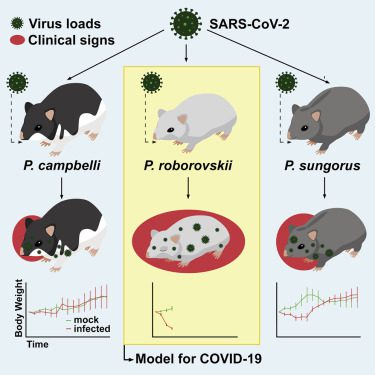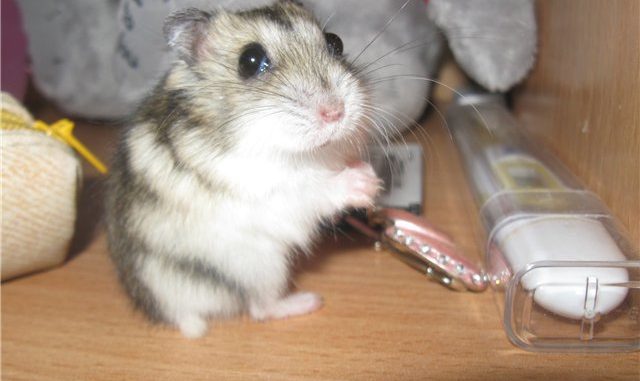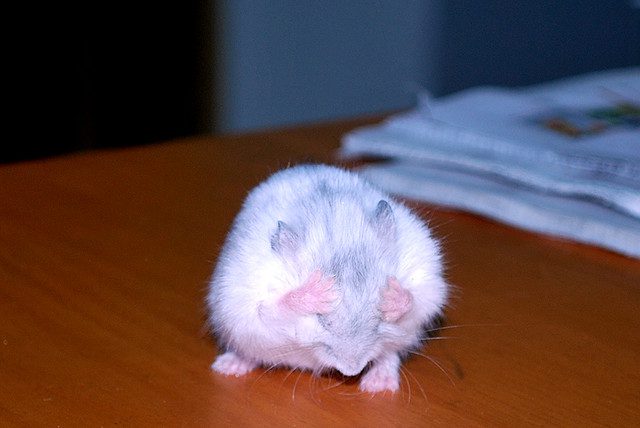
Diseases of the Djungarian hamsters: what the Djungarians suffer from (symptoms and treatment)

Diseases of Djungarian hamsters cannot be distinguished into a separate group, since they are subject to all the same common diseases of hamsters of different breeds. With good care, the animal can live a long life without any ailments, but this is not always the case, and the owner must be ready to help the pet. The main distinguishing feature of the dzungarians is their tiny size and related features of the body.
Contents
Features of the body of the jungar
Since it can be difficult to find a veterinarian specializing in small rodents, the owner must at least in general terms understand what hamsters are sick with and how to treat them.
Fast Metabolism
Due to the intensive metabolism, some diseases in Dzhungaria proceed very quickly. With an intestinal infection, a hamster can die from diarrhea within 1-2 days.
Fragile nervous system
Jungars are stressed. Annoying factors (competition with relatives, noise, disruption of daytime sleep) can themselves lead to illness.
Nervousness leads to disorders of the stool, coat, itching and alopecia.
It should be borne in mind that transportation for the animal can be a stress factor. If the hamster is sick, a visit to the veterinary clinic is necessary, but subsequent procedures are best done at home. The doctor can show how to fix the baby in a safe way and perform manipulations.

Genetic predisposition
Some diseases are much more common in Djungarians than in other hamsters. This is first of all obesity и diabetes. Initially, Campbell’s hamsters are predisposed to diabetes, but they are so similar to Dzungarian hamsters that these two species often interbreed with each other. The owner cannot be sure if his pet is a mestizo.
Hereditary diabetes occurs as early as 2-4 months of age.
Djungarian hamster: diseases of a non-contagious nature
Rodents are often adopted as the first pet. People rely on the unpretentiousness of these animals. And Djungarian hamsters may well become favorite pets: diseases in them rarely occur if they are properly maintained. It is enough to devote time to the prevention of major diseases, so as not to suffer later with treatment.
Obesity
For a small hamster, a smaller cage is often purchased than for a large Syrian or guinea pig. But in nature, a tiny jungarik runs several kilometers every day in search of food. In captivity, he needs to provide conditions for physical activity, otherwise the rodent will quickly get fat. Hamsters’ favorite treats (seeds, nuts) are very high in calories. Although a fat hamster seems funny to owners, being overweight greatly shortens the life of a pet, leads to liver and heart disease, and sometimes provokes diabetes.
Prevention and treatment of excess weight is a diet suitable for the rodent and physical exercises (walks, running in a wheel or a walking ball, game labyrinths).

Diabetes
This is a disease of the pancreas, in which the hormone responsible for the absorption of glucose, insulin, ceases to be produced sufficiently. The disease can be inherited, but most often the owner himself is to blame, feeding the animal tasty, but difficult to digest delicacies. Dangerous for dwarf hamsters is even ordinary carrots, not to mention honey sticks, fruits and berries.
Symptoms:
- change in behavior: lethargy or vice versa – unnatural activity: the animal itches, runs back and forth, digs, jumps);
- a sharp change in body weight: emaciation or obesity;
- the animal drinks a lot and pisses a lot;
Treatment
Small rodents are not given insulin to treat diabetes, so care is based on a special diet. Sweet foods are strictly contraindicated. They give more white vegetables (there are more sugars in red ones): zucchini, cucumber, turnip and radish, celery, Jerusalem artichoke. Limit fats in the diet, increasing the proportion of protein foods (fat-free cottage cheese, boiled meat and eggs).
How to tell if a hamster has diabetes
Instead of a blood test, you can easily do a test at home for the presence of sugar in the urine. Test strips are bought in a regular human pharmacy. A day before the analysis, the hamster is not given any sweet food (fruits, treats). In the morning, the animal is placed in a clean container without filler. For the test, a drop of urine is enough (it is convenient to collect with a syringe). The color change of the test strip is assessed by eye. If the glucose in the urine is higher than normal, the pet is sick.
Inflammation of the cheek pouches
Due to their small size, dzhungars more often injure the mucous membrane of the cheek pouches. The wound can be obtained when feeding seeds in the husk (pumpkin, sunflower), hay, dry pasta. The wound becomes contaminated, inflamed and an abscess is brewing.
The main signs of such a problem are a swelling in the muzzle and a decrease in appetite. The treatment consists in cleaning the cheek pouch, for which it is completely turned out. After opening the abscess, a systemic antibiotic is prescribed.

malocclusion
Like many other rodents, Djungarian hamsters have teeth that grow throughout their lives. It is vital for the animal to grind them down during meals, as well as with the help of a mineral stone or twigs. An unsuitable diet causes malocclusion – improper tooth wear. They grow back, injure the tissues of the oral cavity and jaw bones. As a secondary problem, malocclusion appears after the animal has refused to eat for several days and has received only soft food.
Signs of dental disease:
- refusal of food or selective eating of foods;
- the hamster is losing weight, the process of defecation is disturbed;
- abscesses in the muzzle, discharge from the nose, eyes;
- severe salivation: the fur of the chin and chest is wet, inflamed;
- deformation of the incisors, their growth outside the oral cavity.
It is almost impossible to cure malocclusions, if they once occurred. Correction has to be done repeatedly with an interval of 1-4 months. Teeth trim only under general anesthesia (inhalation anesthesia). Without anesthesia, only overgrown incisors can be trimmed, while the real problem often lies in the molars, chewing (“cheek”) teeth.
Digestive disorders
Feeding “forbidden” foods to the jungarik inevitably leads to disruption of the intestines. Astringents (persimmon) and dry food provoke constipation, fermenting (cabbage, bread, legumes) – bloating, and poor-quality or toxic – diarrhea. It is much easier to prevent such a problem than to treat it, but the owner must be able to provide first aid to the pet. Decoctions of medicinal herbs will come to the rescue: with diarrhea, oak bark, chamomile, and rice water normalize stool.
With flatulence, drink dill water (fennel). For constipation, use the mucus of flax seeds or plantain, vaseline oil.
If there is a suspicion of poisoning, then the hamster can be given sorbents from a human first-aid kit (smecta, enterosgel), but in microscopic quantities.
Djungarian hamster: infectious diseases
When isolated and kept clean infection hamsters are extremely rare. The animal can become infected with food, bedding or from a person – therefore it is so important to wash fruits and vegetables and hands before contact with a rodent. Treatment viral diseases does not exist, and if the doctor has determined bacterial infection – use antibiotics.
Not everyone has the opportunity to contact a specialist with a rodent. Therefore, the owner can resort to antibiotic therapy at his discretion in some situations:
- the hamster has caught a cold and the discharge from the nose is not transparent, but greenish-yellow, (pneumonia);
- the wound is inflamed, or a bump with pus is swollen (abscess);
- profuse diarrhea “out of the blue” (intestinal infection).
Hamsters are sensitive to medicines, so you can’t use human antibiotics – you can’t calculate the dose. The veterinary drug “Baytril 2,5%” is used at a dose of 10 mg/kg (0,4 ml per 1 kg). Dzhungarik weighs about 40-50 g, the dosage for such a crumb is 0,02 ml. Enter subcutaneously, pulling the skin in the area of the shoulder blades. Injections 1 time per day, as prescribed by the doctor 2 times a day, course 1-2 weeks.
skin diseases
A healthy Djungarian hamster has dense, thick, shiny fur. Only on the belly of males is a yellowish “sore” of a rounded shape – a marker gland. If the hamster begins to go bald, combing the skin to the blood – these are signs of serious problems. Most often, rodents are affected by a fungus (mycosporia) and microscopic subcutaneous mites (demodectic mange, itchy scabies). A small bald spot and scratches can be treated with iodine, but you will have to go to the clinic to make a diagnosis. Doctors sometimes give injections of ivermectin (an anti-tick drug) “at random” without finding the parasites themselves. This practice is absolutely justified, you just need to carefully select the dose depending on the weight of the small rodent.
Common diseases of Djungarian hamsters
4 (80.86%) 140 votes







